DefenseMechanisms
Defense Mechanisms
The Importance of Defense Mechanisms
Corals are sessile, colonial organisms, forever fixed in a certain position by attaching as young polyps to a substrate such as a rock or existing coral. This makes the ocean a very dangerous place for these immobile animals. However, in an effort to combat their immobility, many corals have developed different types of defense mechanisms to protect themselves from the ocean's looming dangers--leading to the production of some of the most lethal toxins found in nature. [1][2] In this sense, chemical defense is vital to the life of the coral, whose life depends upon its ability to protect itself from predators and invasive species. In fact, some 73% of all coral is toxic to fish, and most of the other species of coral maintain some physical type of defense mechanism to protect against fish predation. [3]
Chemical Defense Mechanisms
Toxins
Many corals possess toxic defense mechanisms for protection. Toxicity levels of different corals were naturally selected for, which has resulted in a direct relationship between how toxic a particular type of coral is and how much nutrition it provides to those who prey upon it. For instance, fish began preying more often upon those corals that had more nutritional benefits, so those corals had to increase their levels of toxicity in order to protect themselves and survive. Corals that had lower nutritional values were less susceptible to predation, so they did not adapt and increase their toxicity levels the way other types had to. [4]
Fire Coral
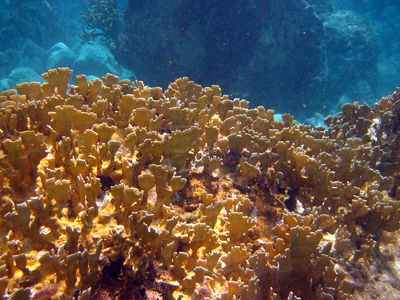
Despite their toxic defense mechanisms, most corals are relatively harmless to humans, with one exception: fire coral. The particular type of proteinaceous toxin in fire coral affects humans, but only mildly — most reactions just involve stinging pain and inflammatory effects, and the more severe, but rare, side effect is nausea or vomiting [6]. The most common toxins are neurotoxins, and there are three main types. Saxitoxins block sodium channels in the body of species it comes in contact with, causing paralysis and respiratory failure. [7] Palytoxins act on the antiporters that control cell membrane activity, thus disrupting the proper functioning of kidneys and red blood cells and leading to kidney, respiratory and heart failure. The third common type of toxin, the lophototoxin, causes muscle contractions and potential paralysis or respiratory failure by blocking the synapses where nerves connect with muscles.[8]
Symbiotic Relationships
Symbiotic relationships, or close relationships between two species that benefit one or both organisms involved, also greatly benefit corals that are not able to produce toxins on their own. The Coral Probiotic hypothesis, for example, posits that a dynamic relationship exists between coral and the large array of bacteria on their surface, so that when environmental conditions change in the oceans, coral can change which microbial partners they are currently maintaining a relationship with in order to more quickly adapt to those changing conditions. [9]
Trapeziid Crab-Stony Coral Symbiosis
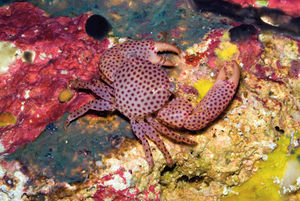
Symbiotic relationships are also maintained between some types of coral and small organisms. The trapeziid crab-stony coral relationship [11] is an example of a symbiotic relationship wherein a small organism (trapeziid crab) lives on the coral reef and benefits the stony coral by removing any excess sediment that falls on the reef. Sedimentation on reefs has been steadily increasing worldwide, but it is detrimental in that it inhibits growth of the coral and accelerates tissue bleaching. In return, the coral offers a few polyps to the crabs as a source of nutritional value for their efforts in cleaning up the reef, in addition to shelter from predation. A healthy coral should have no problem recovering from the trade off of a few polyps. [12] Therefore, the delicate symbiosis existing between the two species must be maintained to support the existence of both species.
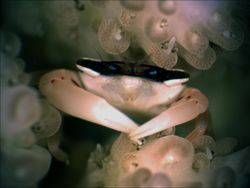
In a field experiment conducted at UC-Santa Barbara, Stewart et. al transplanted sections of stony coral with trapeziid crabs, leaving control transects of the reef free of the tiny crabs. Sedimentation was not enhanced en part of the researchers. Results showed that all corals outplanted with crabs survived, while 45-80% of those outplanted without crabs died (bleached) within a month. Those sections of the coral bleached were without crabs. These results suggest that trapeziid crabs play a crucial role in maintaining the health of the reef, not only for the coral itself, but also the other organisms within the reef [14]
Case Study: Coral and Goby Symbiosis: Defense against Invasive Seaweed
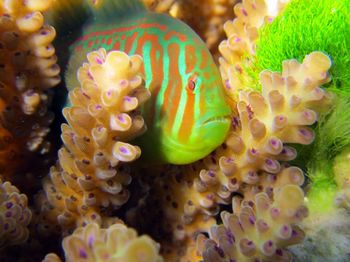
Similar to their constant, encroaching battle with sediment, corals must fight off noxious seaweed in a war for ocean space. Scientists at the Georgia Institute of Technology have discovered that when staghorn species Acropora nasuta detect certain chemical signitures from seaweed, they call on two species of gobies, the broad-barred goby and the redhead goby, whose job is to respond to the chemical signal released by the coral and consume/remove the excess seaweed [16]. In an experiment aimed to elicit this phenomenon, Dixson et. al introduced either turtleweed seaweed or nylon (to mimic the physical structure of turtleweed) to the staghorn coral. Within 3 days, the staghorn colonies infested with seaweed saw 30% less seaweed than before. In this way, the gobies effectively reduced the potential damage to the coral by up to 80% [17]. It is significant to note that the gobies did not respond and remove the nylon when the coral was flanked by its masses, because the coral did not detect the chemical signature from seaweed to start the chain of their own releasing of chemicals. Additionally, it was found that after consuming the toxic seaweed, the toxicity of the predatory broad-barred goby increased as well. The broad-barred goby secretes a toxic mucus in its own defense. [18]
Physical Defense Mechanisms
Nematocysts [19]
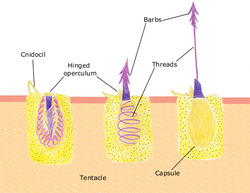
In a cross between a chemical and physical defense mechanism, most corals also have nematocytes for protection — stinging cells on the end of coral tentacles that are used to sting, capture and kill off small prey and neighboring corals in a continuous battle for space. The nematocytes look like double-walled structures that each contain a coiled, venomous thread with a barb at the end, so that when the nematocyte is stimulated either physically or chemically, the thread releases, penetrates its victim's skin and releases poison. [[21]]
Nematocysts are incredibly efficient, especially for their small size and relatively simple structure. When the nematocysts are activated, they fire a barb into the potential victim, which is the physical defense aspect. Then, the barb burrows through the skin of the prey and leaves a hollow filament in its wake, and poison is injected into the new space. The poison then immobilizes the prey, protecting the reef.
Cite error: Invalid <ref> tag; refs with no name must have content.

Cnidocyte
A cnidocyte is the explosive, stinging cell that contains the nematocyst. While cnidarians are incredibly diverse in form, every cnidarian has a cnidoycte for protection. Cnidocytes help the usually quite defenseless cnidarians, like coral, capture prey and defend against predators. When the cnidocyte is stimulated, it fires the nematocyte — the coiled, threadlike structure that contains the toxic — through the cnidocyte wall and into the prey.[[23]]
Notes
- ↑ Van Der Weijden, Sander. "Chemical Defense Mechanisms." Chemical Defense Mechanisms. Coral Publications, n.d. Web. 27 Feb. 2013 [1]
- ↑ "NOAA's Coral Reef Information System (CoRIS) - About Coral Reefs." Coral Ecosystem Publications RSS. National Oceanic and Atmospheric Administration, n.d. Web. 27 Feb. 2013.
- ↑ Chemical Defense Mechanisms on the Great Barrier Reef, Australia – Gerald J. Bakus. Science. New Series, Vol. 211, No. 4481 (Jan. 30, 1981). pp. 497-499
- ↑ Daniels, Ethan. "Reefs of Poison and Venom." Alert Diver. Dan Holdings, Inc., 2013. Web. 23 Apr. 2013. <http://www.alertdiver.com/Poison_and_Venom>.
- ↑ Personal photograph by author. 2013. By Brain Naess
- ↑ Moats, William E. "Fire Coral Envenomation." Wilderness and Environmental Medicine 3.3 (1992): 284-87. Print.
- ↑ Ferrer, Ryan P., and Richard K. Zimmer. "Neuroecology, Chemical Defense, and the Keystone Species Concept." The Biological Bulletin 213.3 (2007): 208-25. Print.
- ↑ Marcus, Erin N. "Marine Toxins." Marine Toxins. Ed. James F. Wiley, II. UpToDate, Inc., 17 Dec. 2012. Web. 27 Feb. 2013.
- ↑ REFERENCE
- ↑ Trapeziid Crab. N.d. Photograph. Fishchannel.com. Web.
- ↑ *Stewart, Hannah L., Sally J. Holbrook, Russell J. Schmitt, and Andrew J. Brooks. "Symbiotic Crabs Maintain Coral Health by Clearing Sediments." Coral Reefs 25.4 (2006): 609-15. Print.[2]
- ↑ "Coral Crabs." Coral Crabs. N.p., n.d. Web. 23 Apr. 2013.
- ↑ Stewart, Hannah. Trapeziid Crab. 2006. Photograph. UCSB. Public Affairs and Communications - Santa Barbara. University of Santa Barbra. Web. <http://www.ia.ucsb.edu/pa/display.aspx?pkey=1505>..
- ↑ Stewart, Hannah L., Sally J. Holbrook, Russell J. Schmitt, and Andrew J. Brooks. "Symbiotic Crabs Maintain Coral Health by Clearing Sediments." Coral Reefs 25.4 (2006): 609-15. Print.
- ↑ Dixson, Danielle. Goby protecting reef. Digital image. N.p., n.d. Web. <http://blogs.discovermagazine.com/notrocketscience/2012/11/09/corals-summon-gardening-gobies-to-clean-up-toxic-seaweed/#.UXc9CivwL41>.
- ↑ Young, Ed. "Corals Summon Gardening Gobies to Clean up Toxic Seaweed : Not Exactly Rocket Science." Not Exactly Rocket Science. Kalmbach Publishing Co., 9 Nov. 2012. Web. 7 Mar. 2013.
- ↑ Young, Ed. "Corals Summon Gardening Gobies to Clean up Toxic Seaweed : Not Exactly Rocket Science." Not Exactly Rocket Science. Kalmbach Publishing Co., 9 Nov. 2012. Web. 7 Mar. 2013.
- ↑ Dixon, Danielle L., and Mark E. Hay. "Corals Chemically Cue Mutualistic Fishes to Remove Competing Seaweeds." Science 338.6108 (2012): 804-07. Print.
- ↑ Kass-Simon, G., and A.A. Scappaticci, Jr. "The Behavioral and Developmental Physiology of Nematocysts." Canadian Journal of Zoology 80.10 (2002): 1772-794. Print.
- ↑ Nematocyst Discharge. N.d. Photograph. National Oceanic and Atmospheric Administration. Web.
- ↑ Kass-Simon, G., and A.A. Scappaticci, Jr. "The Behavioral and Developmental Physiology of Nematocysts." Canadian Journal of Zoology 80.10 (2002): 1772-794. Print.
- ↑ Cnidocyte Diagram. Digital image. Pearson Education, Inc, n.d. Web.>.
- ↑ "Cnidarian Characteristics." Animals / Wildlife. About.com, n.d. Web. 4 Apr. 2013.